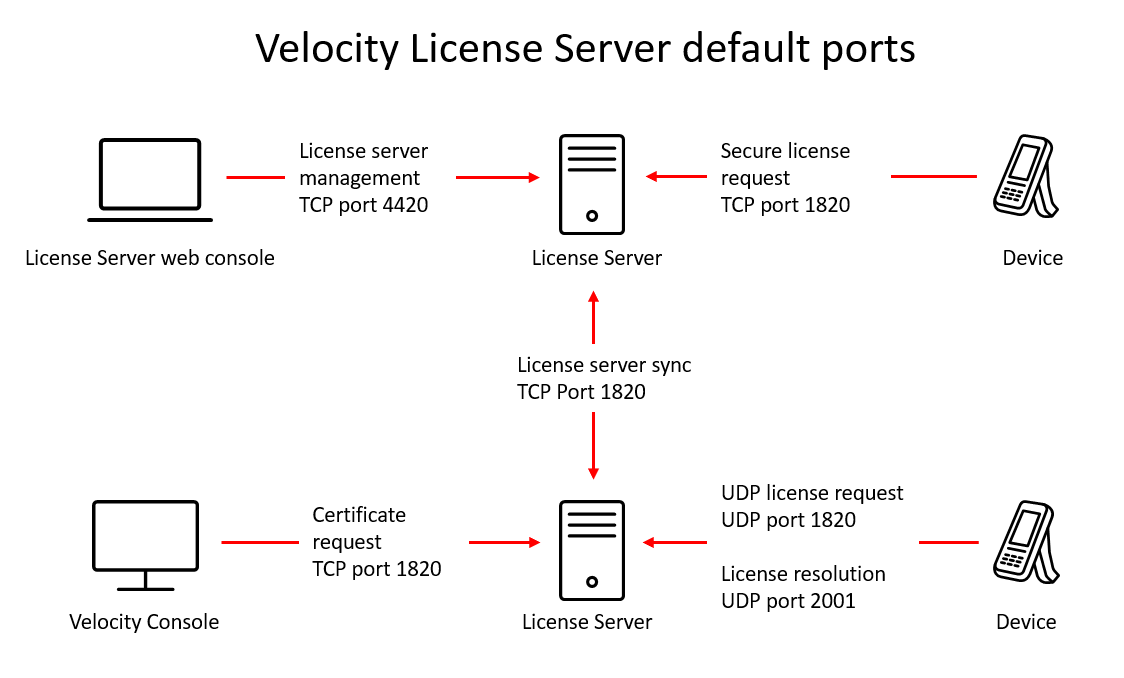Installing the License Server
The system where you install the Velocity License Server should meet the following requirements:
•Windows 10 or newer
-or-
Windows Server 2012 R2, 2016, 2019, 2022, or 2025
•200 MB disk space
You must be logged in to the computer on an account with administrative privileges to run the installer.
If you plan to use a certificate to secure the connection to the License Server Console, you should have the certificate before installing the License Server. Purchase a certificate from a Certificate Authority (CA), or use a self-signed certificate. A self-signed certificate is easier to generate and has no additional cost, but a certificate from a CA is automatically trusted by browsers and may provide better security. For additional information about certificates, see Managing certificates.
If you already have the Terminal Emulation License Server installed, upgrading to this version of the License Server will keep the configuration and license information. For more information on upgrading, see Upgrading the License Server.
When you install the Velocity License Server, it runs as a Windows service. This allows the License Server to automatically start every time the host system is rebooted. Starting in version 5.2, the License Server no longer allows you to select a custom location during installation.
To install the License Server:
1.If you plan to use a certificate from a Certificate Authority to secure communication for devices using the License Server Console, have the certificate added to the Windows certificate store before you begin the installation. For more information, see Managing certificates.
2.Download the License Server installer from the Ivanti web site.
3.Double‐click the License Server installation file. The Velocity License Server Setup Wizard appears.
4.Click Next. The License Agreement page appears.
5.Review the License Agreement and enable the checkbox to agree to the license terms. Click Next. The Legacy License Server page appears.
6.The Use Certificates page appears. Using a certificate is optional, but if you want to set up a certificate, we strongly recommend that you set up the certificate during installation. For additional information about how certificates are used or how to set a certificate up after you've already installed the License Server, see Managing certificates.
•To have the installer create a self-signed certificate and automatically configure the server to use it, select Create and use a self-signed certificate.
•To use a certificate that is in the Windows certificate store, select Choose a certificate from the certificate store. On the Secure Server with SSL certificate page, use the dropdown lists to select the certificate store where the certificate is located and then click Select certificate. Click More choices to see a list of installed certificates. From the list, select the certificate you want to use and click OK. If the certificate is a self-signed certificate, you must enable the Allow invalid certificate checkbox.
•To finish the installation without setting up a certificate, select Do not use a certificate.
When you have configured the certificate information, click Next.
7.Click Install. The License Server will install on your machine.
8.To begin setting up licenses and configuring the License Server, enable the Launch Configuration Page option.
9.Click Finish.
The License Server is installed and the service is started.
If you are using a self-signed certificate and the Launch Configuration Page option was enabled, the default browser will display a warning message that the certificate is invalid. Navigate past the warning by clicking the advanced options.
The License Server installer does not create exceptions in the firewall. You must configure the firewall before the License Server can begin distributing licenses. You can create an exception for the License Server application (C:\Program Files\Wavelink\Velocity License Server\VelocityLicenseServer.Service.exe), or create a rule that allows traffic on the following ports:
•UDP 2001. Used for legacy license distribution. This is not used if you have Force secure delivery of licenses enabled.
•UDP/TCP 1820. (Configurable.) Used for license distribution. UDP is not used if you have Force secure delivery of licenses enabled.
•TCP 4420. (Configurable.) Used for accessing the License Server Console.
To start or stop the License Server service:
1.From the Windows Start menu, type Services and select the Services app.
2.From the list of services in the Services app, select Velocity License Server.
3.In the left pane of the Services console, select the appropriate link to Start, Stop, or Restart the service.
‐Or‐
Right‐click the Velocity License Server line and select Start, Stop, or Restart from the context menu.
You cannot access the License Server Console if the service is stopped.
To uninstall the License Server:
1.From the Start menu, select Add or remove programs. Or open the Settings app and navigate to Apps & features.
2.In the list of applications, select Velocity License Server.
3.Click Uninstall.
4.A dialog box appears asking you to confirm that you want to uninstall.
5.Click Yes.
